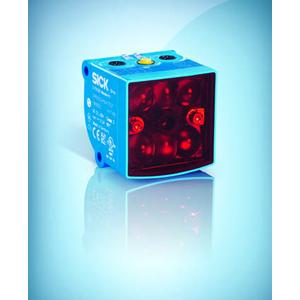The Glare detector is the ideal gloss sensor for detecting and distinguishing objects according to their level or degree of brilliance in order to control production processes.
Thanks to this gloss sensor, it is thus possible to detect the brightness characteristics of various materials and surfaces irrespective of color, transparency or patterns without contact and reliability. The brightness optical characteristic generally refers to the ratio of diffuse light reflected to the directionally reflected light.
Thus, for the detection of transparent safety labels, the sensor knows how to distinguish between the powerful directional reflection of the plastic surface and the diffuse reflection of the raw surface of the packaging material. The Glare Glare Detector is not only more economical and easier to integrate into industrial processes, but is also used without taking into account reflectometric standards for the measurement of high gloss, moderate gloss and Matt material. Indeed, it gives no indication of the brightness index in UB (brightness units), but signals by its two digital digital outputs the result of the difference in brightness detected.
The Glare sensor has a detection distance of 50 mm and has two receiving cells for eight transmitter axes. The red LEDs emit in different directions and generate a light spot about 10 mm x 13 mm. Thanks to this structure, the sensor is perfectly insensitive to the vibrations caused by the machines in operation or to the inclination of the moving objects. It ensures reliable detection of gloss variations between the label and the packaging.
As an option, the Glare can be integrated into the machine control via IO-Link. This makes it possible to parameterize the sensor from the control and to have complete process data that can be evaluated in the PLC or the control interface.
Thanks to this gloss sensor, it is thus possible to detect the brightness characteristics of various materials and surfaces irrespective of color, transparency or patterns without contact and reliability. The brightness optical characteristic generally refers to the ratio of diffuse light reflected to the directionally reflected light.
Thus, for the detection of transparent safety labels, the sensor knows how to distinguish between the powerful directional reflection of the plastic surface and the diffuse reflection of the raw surface of the packaging material. The Glare Glare Detector is not only more economical and easier to integrate into industrial processes, but is also used without taking into account reflectometric standards for the measurement of high gloss, moderate gloss and Matt material. Indeed, it gives no indication of the brightness index in UB (brightness units), but signals by its two digital digital outputs the result of the difference in brightness detected.
The Glare sensor has a detection distance of 50 mm and has two receiving cells for eight transmitter axes. The red LEDs emit in different directions and generate a light spot about 10 mm x 13 mm. Thanks to this structure, the sensor is perfectly insensitive to the vibrations caused by the machines in operation or to the inclination of the moving objects. It ensures reliable detection of gloss variations between the label and the packaging.
As an option, the Glare can be integrated into the machine control via IO-Link. This makes it possible to parameterize the sensor from the control and to have complete process data that can be evaluated in the PLC or the control interface.
